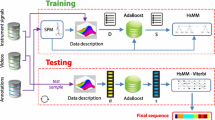Abstract
Purpose
Analyzing surgical activities has received a growing interest in recent years. Several methods have been proposed to identify surgical activities and surgical phases from data acquired in operating rooms. These context-aware systems have multiple applications including: supporting the surgical team during the intervention, improving the automatic monitoring, designing new teaching paradigms.
Methods
In this paper, we use low-level recordings of the activities that are performed by a surgeon to automatically predict the current (high-level) phase of the surgery. We augment a decision tree algorithm with the ability to consider the local context of the surgical activities and a hierarchical clustering algorithm.
Results
Experiments were performed on 22 surgeries of lumbar disk herniation. We obtained an overall precision of 0.843 in detecting phases of 51,489 single activities. We also assess the robustness of the method with regard to noise.
Conclusion
We show that using the local context allows us to improve the results compared with methods only considering single activity. Experiments show that the use of the local context makes our method very robust to noise and that clustering the input data first improves the predictions.






Similar content being viewed by others
References
Bardram JE, Doryab A, Jensen RM, Lange PM, Nielsen KL, Petersen ST (2011) Phase recognition during surgical procedures using embedded and body-worn sensors. In: IEEE international conference on pervasive computing and communications, pp 45–53
Blamoutier A (2013) Surgical discectomy for lumbar disc herniation: surgical techniques. Orthop Traumatol Surg Res 99(1):S187–S196
Bouarfa L, Jonker PP, Dankelman J (2011) Discovery of high-level tasks in the operating room. J Biomed Inform 44(3):455–462
Bricon-Souf N, Newman CR (2007) Context awareness in health care: a review. Int J Med Inform 76(1):2–12
Forestier G, Lalys F, Riffaud L, Collins DL, Meixensberger J, Wassef SN, Neumuth T, Goulet B, Jannin P (2013) Multi-site study of surgical practice in neurosurgery based on surgical process models. J Biomed Inform 46(5):822–829
Forestier G, Lalys F, Riffaud L, Trelhu B, Jannin P (2012) Classification of surgical processes using dynamic time warping. J Biomed Inform 45(2):255–264
Forestier G, Petitjean F, Riffaud L, Jannin P (2014) Non-linear temporal scaling of surgical processes. Artif Intell Med 62(3):143–152
Franke S, Meixensberger J, Neumuth T (2013) Intervention time prediction from surgical low-level tasks. J Biomed Inform 46(1):152–159
Hall M, Frank E, Holmes G, Pfahringer B, Reutemann P, Witten IH (2009) The WEKA data mining software: an update. ACM SIGKDD Explor Newsl 11(1):10–18
Lalys F, Bouget D, Riffaud L, Jannin P (2013) Automatic knowledge-based recognition of low-level tasks in ophthalmological procedures. Int J Comput Assist Radiol Surg 8(1):39–49
Lalys F, Jannin P (2013) Surgical process modelling: a review. Int J Comput Assist Radiol Surg 8(5):1–17
Lalys F, Riffaud L, Morandi X, Jannin P (2010) Automatic phases recognition in pituitary surgeries by microscope images classification. In: Information processing in computer-assisted interventions, vol 6135. Springer, pp 34–44
Mehta N, Haluck R, Frecker M, Snyder A (2002) Sequence and task analysis of instrument use in common laparoscopic procedures. Surg Endosc 16(2):280–285
Meißner C, Meixensberger J, Pretschner A, Neumuth T (2014) Sensor-based surgical activity recognition in unconstrained environments. Minimally Invasive Therapy & Allied Technologies
Padoy N, Blum T, Feussner H, Berger MO, Navab N (2008) On-line recognition of surgical activity for monitoring in the operating room. In: AAAI, pp 1718–1724
Padoy N, Mateus D, Weinland D, Berger MO, Navab N (2009) Workflow monitoring based on 3d motion features. In: IEEE international conference on computer vision workshops, pp 585–592 (2009)
Quinlan R (1993) C4.5: programs for machine learning. Morgan Kaufmann Publishers, San Mateo
Riffaud L, Neumuth T, Morandi X, Trantakis C, Meixensberger J, Burgert O, Trelhu B, Jannin P (2010) Recording of surgical processes: a study comparing senior and junior neurosurgeons during lumbar disc herniation surgery. Neurosurgery 67:325–332
Sebban M, NockO R, Chauchat J, Rakotomalala R (2000) Impact of learning set quality and size on decision tree performances. IJCSS 1(1):85
Shi Y, Bobick A, Essa I (2006) Learning temporal sequence model from partially labeled data. In: 2006 IEEE computer society conference on computer vision and pattern recognition, vol 2. IEEE, pp 1631–1638
Stauder R, Okur A, Peter L, Schneider A, Kranzfelder M, Feussner H, Navab N (2014) Random forests for phase detection in surgical workflow analysis. In: Information processing in computer-assisted interventions. Springer, pp 148–157
Varadarajan B, Reiley C, Lin H, Khudanpur S, Hager G (2009) Data-derived models for segmentation with application to surgical assessment and training. In: Medical image computing and computer-assisted intervention-MICCAI 2009. Springer, pp 426–434
Ženko B (2008) Learning predictive clustering rules. Informatica 32:95–96
Acknowledgments
The authors would like to thanks all the surgeons of the Neurosurgery Department of the Leipzig University Hospital, Germany involved in this work. The authors would like to thank the anonymous reviewers for their valuable comments and suggestions to improve the manuscript.
Author information
Authors and Affiliations
Corresponding author
Rights and permissions
About this article
Cite this article
Forestier, G., Riffaud, L. & Jannin, P. Automatic phase prediction from low-level surgical activities. Int J CARS 10, 833–841 (2015). https://doi.org/10.1007/s11548-015-1195-0
Received:
Accepted:
Published:
Issue Date:
DOI: https://doi.org/10.1007/s11548-015-1195-0




